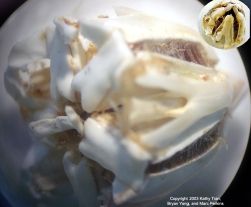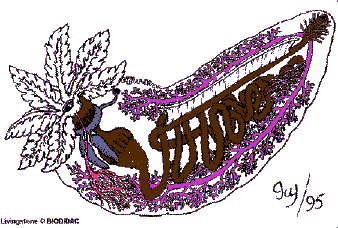This is a holothurian:

The simple, and humble sea cucumber. Not much to look at, is it? A very odd relative to those sea urchins you might have has the misfortunte of stepping on at the beach at a tide pool, or those things you see those cute little sea otters hammering open on TV, they're really not all that spectacular. Well, except for the fact that they come in such cool colours. That and the fact that they breath through their ass.

No, seriously. In this picture you can see the tentacles used for respiration very well; it's a highly branched structure used by members of the holothuroidea for breathing. It's on the anterior end of the organism, yet, it's directly connected to the anus - on the
posterior side of the organism. I think the respiratory tree is made up of highly modified tentacles, which makes it clear that the anal connection may have been a vestige of the tree's original role in feeding.
One of the rather...odd abilities of at least some holothurians is that when threatened, they can actually expel out all of their internal organs into the environment, not unlike a lizard leaving its tail behind when it escapes. Yes, that's right:
all of its internal organs. And sure enough, they can be completely regenerated.
-
This is
Aristotle's Lantern:

It's the feeding structure used by sea urchins when they graze on algae. It's heavily made up of bone and collagen - oh, but this isn't ordinary collagen. Not our kind of "set-it-and-forget-it" collagen, like the kind present in our joints. No, this is
flexible collagen.
So imagine, if you will, a future where people get involved in horrific accidents, macerating their internal organs, destroying their joints...and people like that, who would have had no chance for survival, let alone any sort of recovery, being able to
completely regenerate their organs and have fully functional joints that can still work as well as the day they were made.
-
Or, imagine a miracle device you can carry around with you on your next hike in the forest or up in the mountains. You bought it for $99.99 at RadioShack earlier, as a toy for your kid's day camps to the forest; you see an interesting beetle scurrying about, and you catch it, prick it's softer underside with a needle, and instantly a micro gene sequencer goes to work. It uploads its results instantly via wireless connection to conservation authorities, the location logged via a built-in GPS sensor. A message has flashed on the device's screen: congratulations. You've just indentified a new
Asian Longhorn Beetle infestation, and may very well have helped save the forest from a terrible fate.
This is what biology is to me. I've heard it said on message boards and forums that there's little more to biology than useless memorization, but here,
here is where such people are horribly, horribly wrong. How can holothuroidians regenerate their entire bodily organs? How and why is sea urchin collagen different from our own? We don't know, and that's what makes biology so damn cool. The ratio of what we know versus what we don't know is staggeringly small.
A lot of people don't understand that, and I think I'm starting to realize why. Vision. It's all a matter of vision. I think that you really need some sense of vision to truely understand the embarassment of riches that we have out there, a wealth which we hardly notice, let alone appreciate. I look at things like that which I've seen and my mind just boggles at the possibilities. We don't all have to be rabid, foaming-at-the-mouth taxonomists to really get a sense for what's out there. All we really need is the vision to really, truly see it.
The question then is, how much of that vision do we have left? And how much of it are we using?









